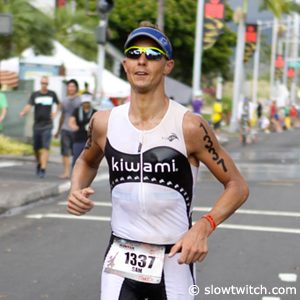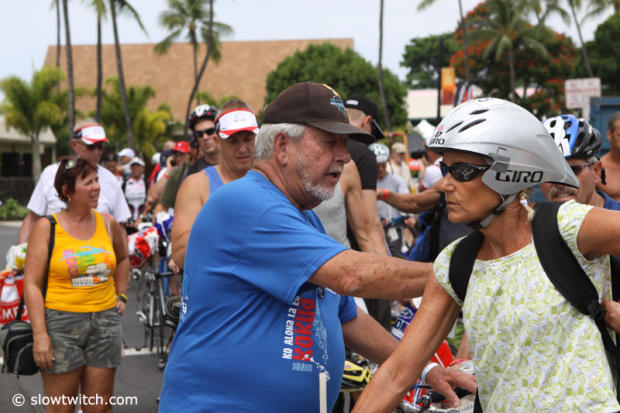A chat with Nicolas Hemet
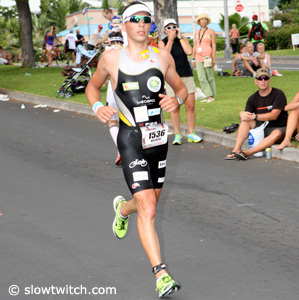
French age grouper Nicolas Hemet went 9:03:11 in Kona and was 45th overall, but in the strong M30-34 age group that meant 8th place. But Nicolas still seems to be in a content place.
Slowtwitch: Well, are you happy with your race?
Nick: It's hard not to be happy with a PR on this race, a better place than my best one before. A few minutes before the start, I was already satisfied and happy just by being healthy and relaxed compared to 2009 where I started sick, with an empty belly and a full of regrets head! Everyone who experienced a 'did not start' or gave up soon in a race due to healthy problems will understand what I mean. The disappointments or limits to that happiness are growing the days after the race by reliving the race scenario, reviewing the splits and finding some errors, some moments of weakness that should have not happened… but maybe I'm searching for them to give me a reason to keep on training and staying motivated so I don't forget to be mostly happy.
ST: Talk about your day.
Nick: I woke up at 4am after a good night and after the breakfast went down to Kona (I was living in Holualoa). There I had last preparations with Christophe, a rookie in Kona and one of the athletes I coach. Slowly time to race arrived. I succeed to keep my place on the first line and had a good start. Despite this start, it was rush hour at each buoy and I lost my glasses, which I fortunately succeed to re-attach. At the next buoy, someone pull my left ankle and it made a big crack. Not especially painful and I moved on. I swam 59', so a little more than I expected, but nothing important. On the bike, I had planed to ride a strong first hour to avoid drafting problems, to pace normally until Kawaihae and then rest a little to recover from the first hour before the Hawi climb. The conditions were good so it helped me to stay with this plan. After the U-Turn, I didn't succeed to catch my special needs bag which held my second aero bottle, so I had to manage with only a 500ml front tank as my bottle holder wasn't accepting a round bottle. It forced me to sometimes slow down a little between two aid stations in order not to overheat but it may have been a good thing for a conservative ride. I finished with a 4h46' time on bike, thanks to the good weather conditions. I went out of T2 in 5h50 so my goal at this time was to go for sub-9 instead of the 9h04 I had planned and announced on my blog. But in the first hundred meters, I discovered that my left ankle lost his flexibility (reminding me the swimming incident) and my left calf was directly “out of order”. I adapted my stride to it but mentally instead of being aggressive as necessary, I started to be defensive and was always feared (especially on the uphill rollers of Alii Drive or on Palani Road) to stretch out my calf. During 18km, it didn't affect that much my pace and I was still on my plan. But at the first downhill on the Queen K, this new stride induced a nail issue, which was hurting me really hard. I then had the mental weakness to downgrade my goal to my former ambition and reduced the pace. I also probably made a nutrition mistake at that point (or a few km before) and I lost between mile 20 and 24 almost all the places I had gained before. In the end I ran 3h12 for a 9h03 final time.
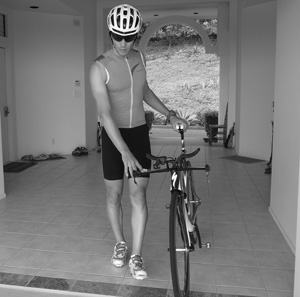
ST: What expectations did you have going in?
Nick: I had dreamed and trained for about 58' / 4h48 / 3h07 so a 8h59 but had 13 mini-expectations. I realized 9 of them.
ST: What bike were you riding and who did the fit with you?
Nick: I was riding a 2011 Specialized Shiv and fitted myself. I hope I won't be killed on the forum for that 😉
ST: Did you feel fine during the run?
Nick: In terms of breathing and perceived exertion, yes, but my left calf and then also one of my left foot nails, fine wasn't the exact feeling.
ST: How many guys in your category caught you during the run?
Nick: I really don't know as I wasn't informed about my age group place and didn't want to. I race against myself and I'm not responsible if the guys are better or improving faster or if the field is exceptionally strong or dense which seems to have been the case in my age group. After the race I discovered that I have been a long time in 3rd position in my AG and finished 8th, 5 minutes from 2nd place and 1'30 from the 5th place synonymous with the podium. That would have pleased my ego and looked well on my desk. But that is how it is. Congrats to the other guys!
ST: Any thoughts on drafting in Kona? What did you see or notice?
Nick: I was worried about it and had trained to be able to make a strong first hour to be away of this problem as soon as possible. I went out of the water around the 100th AG position and was around the 20th position at mile 30. I saw like everyone else that big pack that was reported and pacing for around 6h20 at the end of bike. But an athlete I'm coaching managed without too much difficulty to pass this pack. He went from 1250th position at the end of the swimming leg to around 450th place at the end of the bike leg. With a pretty similar level in both disciplines, he didn't succeed to move forward at Clearwater 2010. It is not comparable, and it's really possible to ride clean a Kona even by going out of the water around 1h05 where the density is the highest. It is not perfect and I'm not blind but the weird bike times or really surprisingly fresh fast marathons as you see on some Ironmans (Florida, Klagenfurt) from people you know that haven't this level doesn't occur in Kona. There must be some cheaters that succeed to escape to penalty but they are by far a minority. I'm for all the solutions to prevent drafting: wave starts, time trial, less qualified athletes, a lot of split mats and analyses to see who was always together, hidden video, helicopters, accurate GPS in the bike plate with time count when you are more than certain straight seconds at less than 7 meters from another, all you can imagine … and I'm ready to pay for it but as the drafting kills the spirit of the long distance triathlons, IMHO, bad and lazy ways to do it are killing this battle.
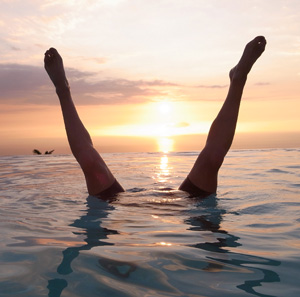
ST: In 2007 you finished 8th in your age group in Kona in a time of 9:15. Four years later 12 minutes faster gets you 8th again but at least a top 50 overall. What should we expect in 4 more years?
Nick: If we take the gap behind the leader, it was the same. A little more than 59' minutes behind the winner, so even if I think the level is growing in density my two races doesn't prove it, except if you consider Crowie far better than Macca. I think the 8h barrier will be broken, I think a podium in the 25 to 39 AG will require more often a sub9.
ST: You also started Kona in 2009, but did not finish. What happened?
Nick: I qualified at Lanzarote by winning my AG relatively “easily” and had the stupidity to think Ironman wasn't that hard. Actually, I had only the luck to be in a real good day, to have a protective strategy and to be fresh (not a lot of work in the month before) at the start. For Kona, I tried to be a good family father and made the 24h trip with my wife, my 2yo daughter and 2mo son. I let you imagine the travel. I also had to work a lot as I was race director of a marathon scheduled to take place 8 days after Kona. I refused to give some parts of my job to volunteers that proposed to unload me from it. It didn't work well, I didn't offer the perfect holiday trip to my family and friends that joined us and I didn't have a good race. I was in a permanent conflict between those 3 choices and it ruined me. Two days before the race I felt sick but it had nothing to do with luck. I couldn't eat anything from Thursday afternoon till race day morning. I finally succeeded to have solid food two hours before the start, and I decided to start and take as much experience as possible. It ended around mile 30, exhausted and in a way happy to end this nightmare. I learned a lot from this failure and it makes me see the things differently.
ST: Your fastest race though was in Roth in 2008. Is that where you have to go if you want a personal best?
Nick: I did it in a really bad weather day, the slowest editions in at least 10 years, with 12°c, and pouring rain during the whole bike leg. By km 50 I was freezing despite a parachute jacket and had the choice between hammering for 15-20' or dropping out. Fortunately I succeeded to warm up this way but I finished frustrated about the final time and struggled a lot in the last 10km. It took me 4 months to completely recover from this race. The race is superbly organized, the bike time can be really fast, due to the smooth pavements, the long downhills after short steep uphills but also due to some missing kilometers. As doping and drafting, I'm against this European tendency (what about Klagenfurt this year, or Ironman France) to make bike leg more around 175km and marathon leg around 41km and even less sometimes. I can't imagine it is not done one purpose to artificially fasten the final times and attract athletes who want a more glorious time. I spent a lot of time to write a spreadsheet about it and will update it as some races changed their legs in between. Roth is a very nice and fast race but not a complete distance. Those things wouldn't be possible in a big sport and I don't want to participate in it. That's why I registered to Busselton (Ironman Western Australia) twice and probably will do Ironman Germany next year.
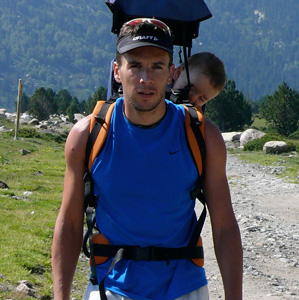
ST: How accurate do you think that course is?
Nick: In 2008, the marathon was different than since last two years. The bike portion had also a small exceptional modification in 2010 as far as I remember. I have to check this during next off-season. As in my former job (marathon race director) I did a lot of IAAF measurements with the Johns mechanical counter, I know how to compare to GPS measurements and map measurements like on openrunner.com to give a sharp idea of either the distance was full or not.
When I did it in 2008, I did not check the swim but it seemed to be accurate, I had around 177km on bike and around 41,5km on run.
ST: How big was your weekly training load going into Kona?
Nick: It was the smallest training load compared to my former preparations with a annual 13hr/week including the 18hr/week averaged in the last 12 weeks. But I did very specific work-outs including some big training days including a full Ironman distance on the 28th of August where I planed to drop at km15 on the run leg but finally finished on jogging pace.
ST: What is your day job?
Nick: Since the end of May '11 I'm full time multisport coach with 18 athletes and a club.
ST: With your coaching job you are really not that different from many Pros who make their living in a similar fashion.
Nick: I don't know how many athletes they care about and how they work but the way I do it, it takes much more work and stress than all my former full-time (35-37h/week in France) jobs; as I told you before, it was my lightest Ironman preparation so far and it is mostly due to this job. But I'm not complaining, it is a choice and it also brings me a lot of positive things.
ST: What food likes and dislikes do you have?
Nick: Quite simple, I like mostly things that are not so healthy: cookies, sorbets, fine chocolates and my favorites: macaroons from LaDurée. And I don't dislike a lot of things, that's my problem.
ST: Anything else we should know?
Nick: I had 5 amazing supporters flying 20 hours just in order to be burned in the sun by waiting for me. I'm so grateful to Antoine, Fabien, Gladys, Hervé and Olivier – you are the best.


